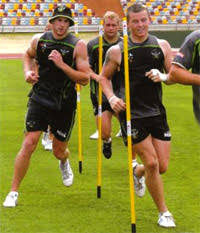Dryland or cross training for those who aren't swimmers has always been a big part of my practices as long as I have been coaching. I have had great results and am always continuing look for ways to be better. I think in order to have a dryland program that really helps your team, you need to be patient, commit to it, and you have to allow time for the routine to develop. I think there are 3 stages of dryland.

1.
Effort: If you are just trying to build aerobic capacity, it doesn't have to all be in the pool, you can substitute many things that can be just as good as 10 X 100. The important thing is to find something that works with your facility, the team can have fun with, and everyone will work hard and sweat a little. I think too often coaches start with a routine that is too complicated or expect too much out of their athletes, or expect their team to have elite athletic coordination right away. Find some space like a football field, track, parking lot, or park and just create laps, make the team run different ways, forward, backward, skipping, shuffling, big jumps, little jumps. Your number one priority is to create a great team effort. If you can get a great effort out of your team, you are well on your way.

2.
Muscles: Once you develop the team effort, now you can start getting a little more specific in the routines, and you can start targeting swimming muscles and core muscles. Usually this takes a little more discipline and maturity out of your athletes. I have witnessed many teams performing sub par ab routines, med balls, and weight sessions because they didn't establish the effort first. Make sure you are starting with routines that are easy to grasp and match your teams athletic ability. Start teaching a little more about why we are targeting these muscles and how they will apply to their swimming speed and injury prevention. If you can get to this step with a good effort, you will start seeing even better results in the water. Teaching basic Squats, Lunges, Pullups, Pushups and med ball work is appropriate here.
3.
Connection: The final stage is the when the athlete can take the effort and the muscles and then make the connection to how they move in the water. Again the routines will become more complex, and it will take even more discipline from the athlete to do the routine correctly. Once the athlete can grasp the connection to how the movement and resistance correlate to their events, the sky is the limit as to how far the coach and athlete can get. This is when you start adding olympic lifts, complex routines, advanced med ball routines, and power sessions. Be creative, but you need the effort and muscle first!
Don't get ahead of yourself. There are so many cool things you can find on youtube that you want to try with your team, but sometimes your athletes are not ready for them yet, and you will set them up for failure. Keep it simple, start with effort, then get muscle specific, and then connect the movement.
No comments:
Post a Comment